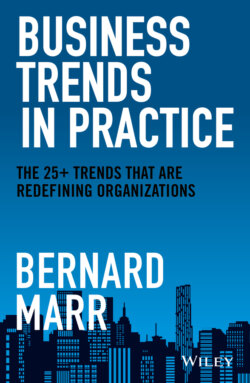Читать книгу Business Trends in Practice - Бернард Марр, Bernard Marr - Страница 44
What do we mean by digital transformation?
ОглавлениеTo realize this vision of smarter, more diverse energy grids, we need intelligent devices and technology that: a) help us communicate with the grid so demand can be monitored and managed, and b) help us all reduce our energy consumption. I briefly alluded to some examples in the previous section, but let's see what else is involved in the digitization of energy (many of which are key tech mega-trends covered in the previous chapter). Together, these digital solutions have given rise to the term Energy 4.0, a play on Industry 4.0 or the fourth industrial revolution that I referred to at the start of Chapter 2.
AI and predictive analytics : These are used to analyze and predict demand, adjust where power is drawn from on distributed grids, and predict equipment failures. GE, for example, uses AI to predict failures ahead of time at wind and solar plants.17
The Internet of Things: In particular, the use of smart home thermostats and home energy management systems such as Google Nest is helping consumers cut their energy usage and heat their homes more efficiently.
Blockchain: From secure, smart contracts to facilitating distributed networks, blockchain could be a transformative technology for the energy sector. In one example, Turkish startup Blok-Z's blockchain technology enables anyone to access economical, transparent and traceable green electricity.
Quantum computing: The sheer power of quantum computers is ideally suited to solving the unique and vast challenges facing the energy sector. As an example, US-based startup QC Ware provides quantum computing solutions to help optimize energy use (including energy prediction and demand management).
Digital twins: A digital twin is an advanced digital duplicate of a real-life object, system, or process. By using information gathered from IoT sensors in the real world, organizations can model changes and try them out in the digital twin without making expensive or high-risk alterations to the real-life counterpart. BP, for example, uses digital twins to model new oil field production.18 In another example, MHPS-TOMONI's digital twin technology can create a virtual replica of a power plant or even an entire grid.19
As that last example suggests, these technologies don't just apply to innovative decentralized energy grids and renewable sources. Even with traditional, centralized operators, digital innovation can help energy providers cope with uncertainty, make better decisions, and improve efficiency in an increasingly competitive field. According to McKinsey, energy companies that have invested in digital innovation have seen up to 10 percent improvements in production and yield, and up to 30 percent improvements in costs.20
